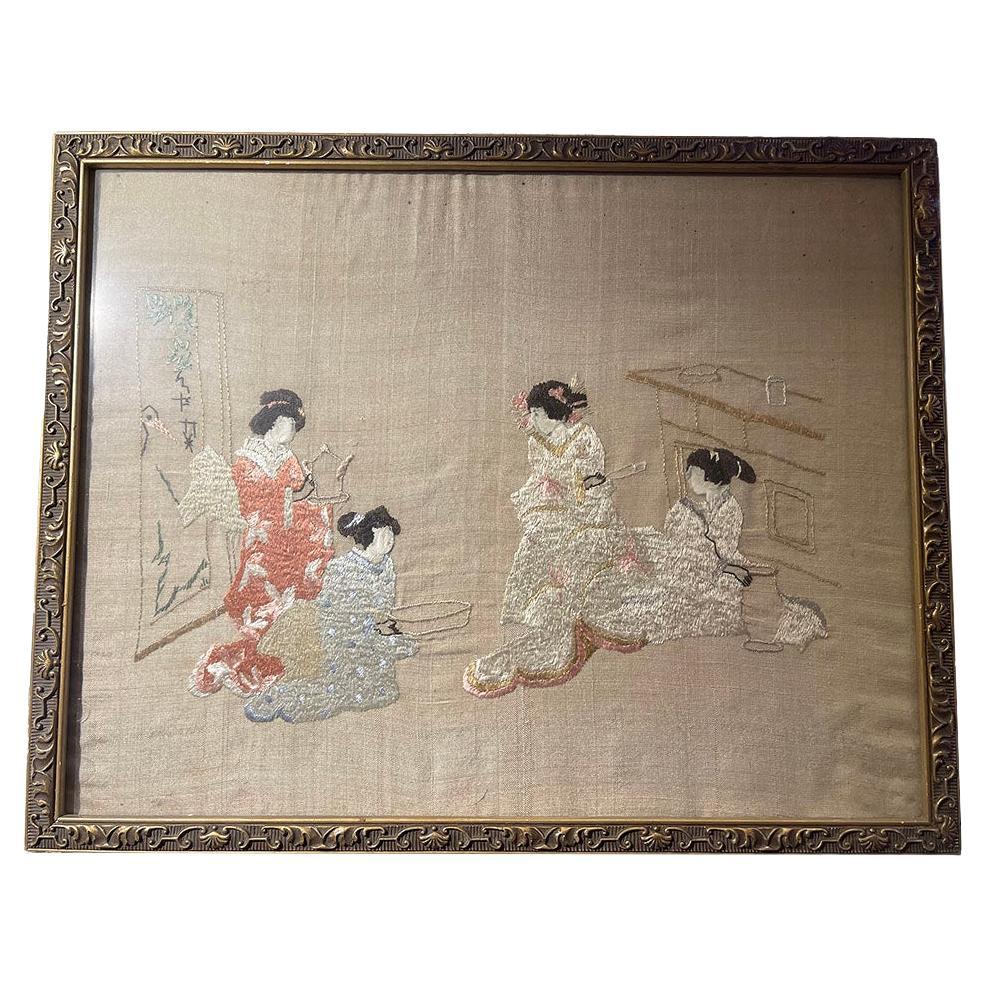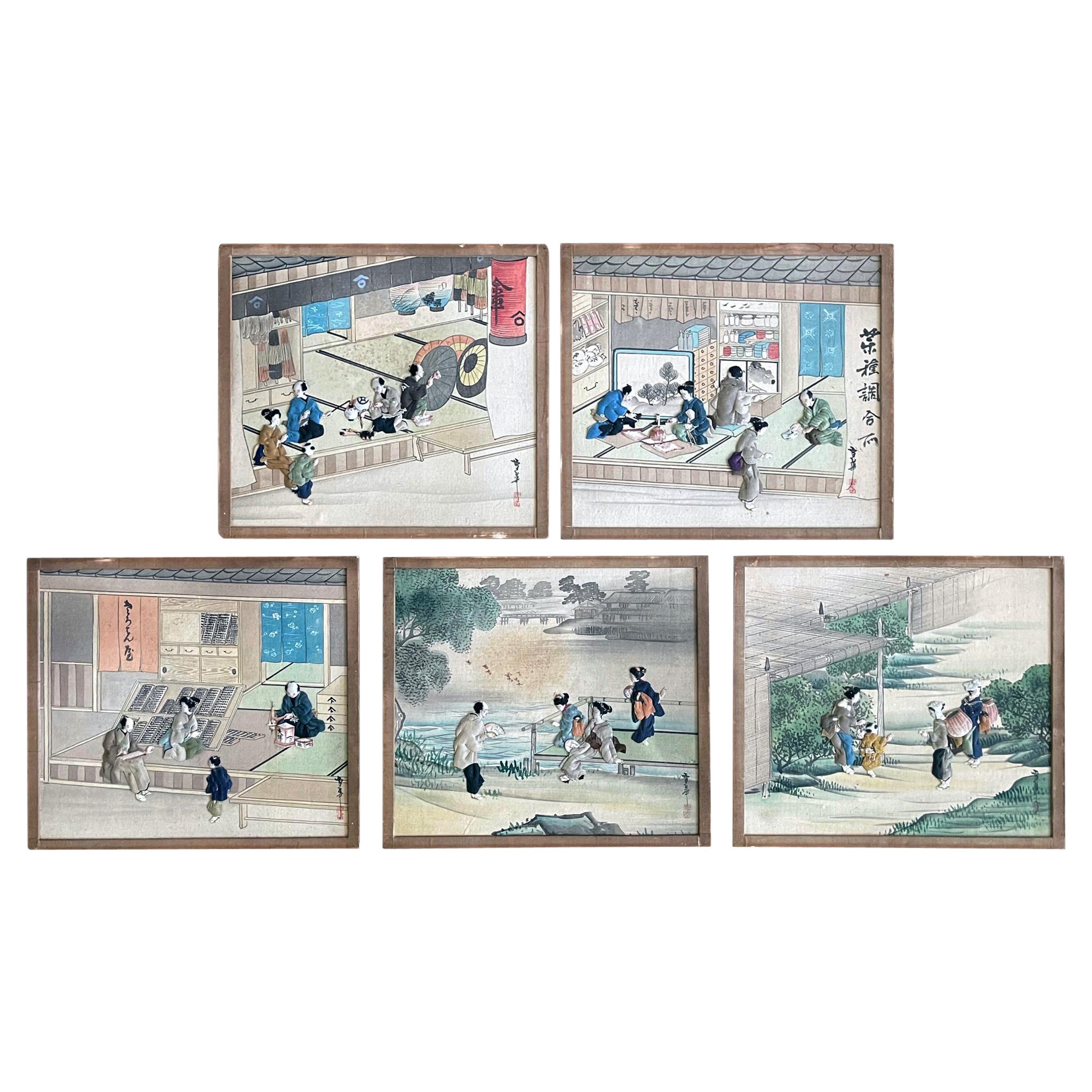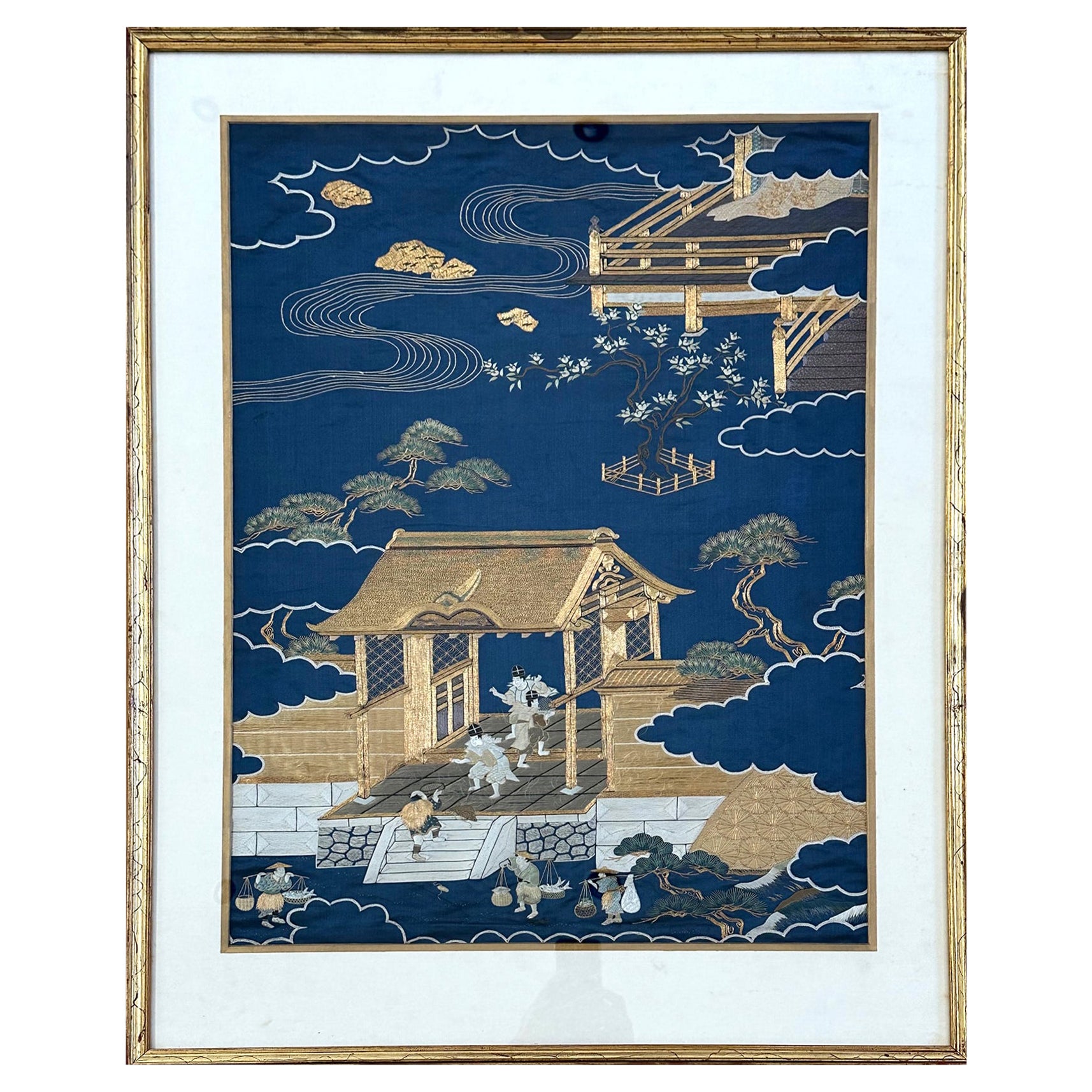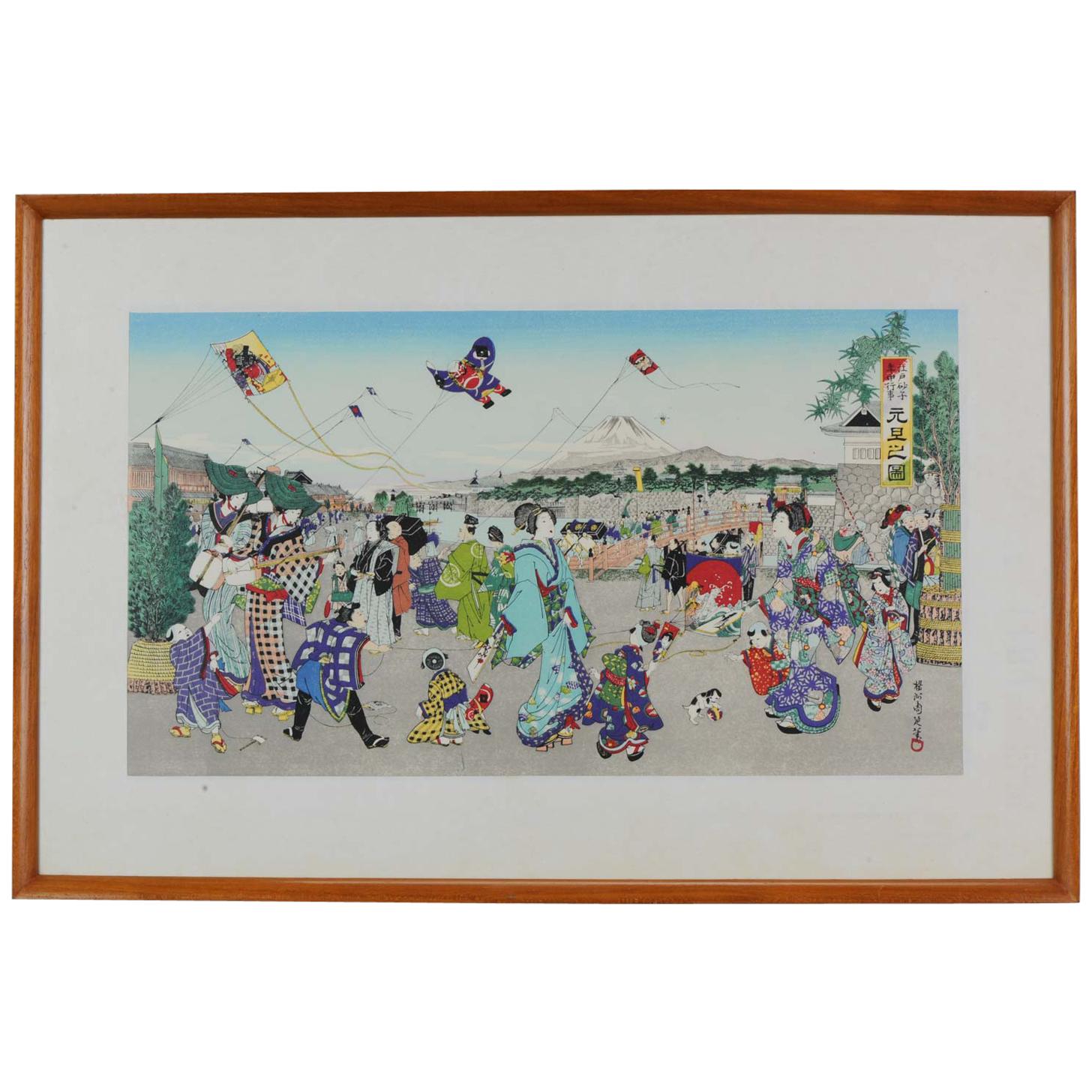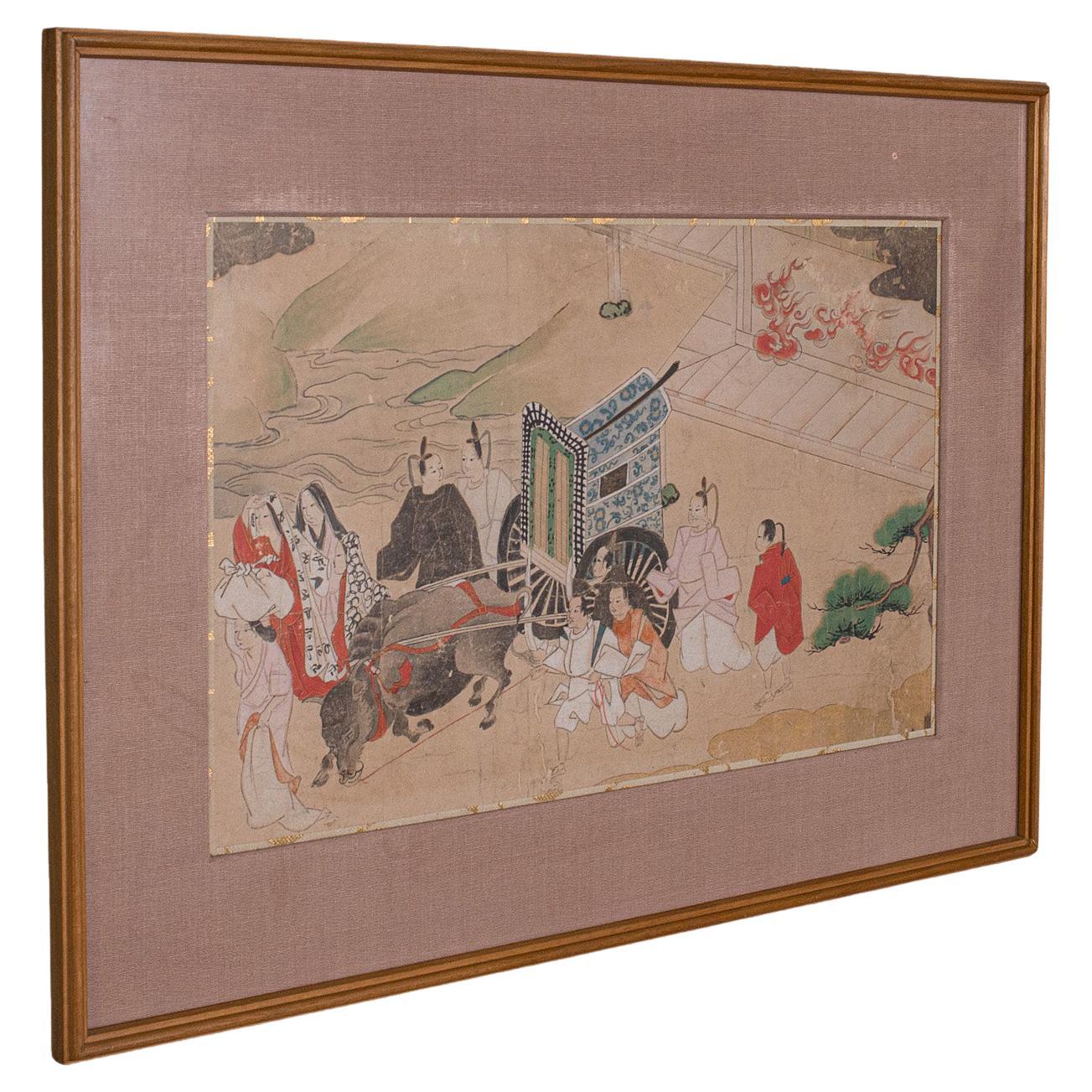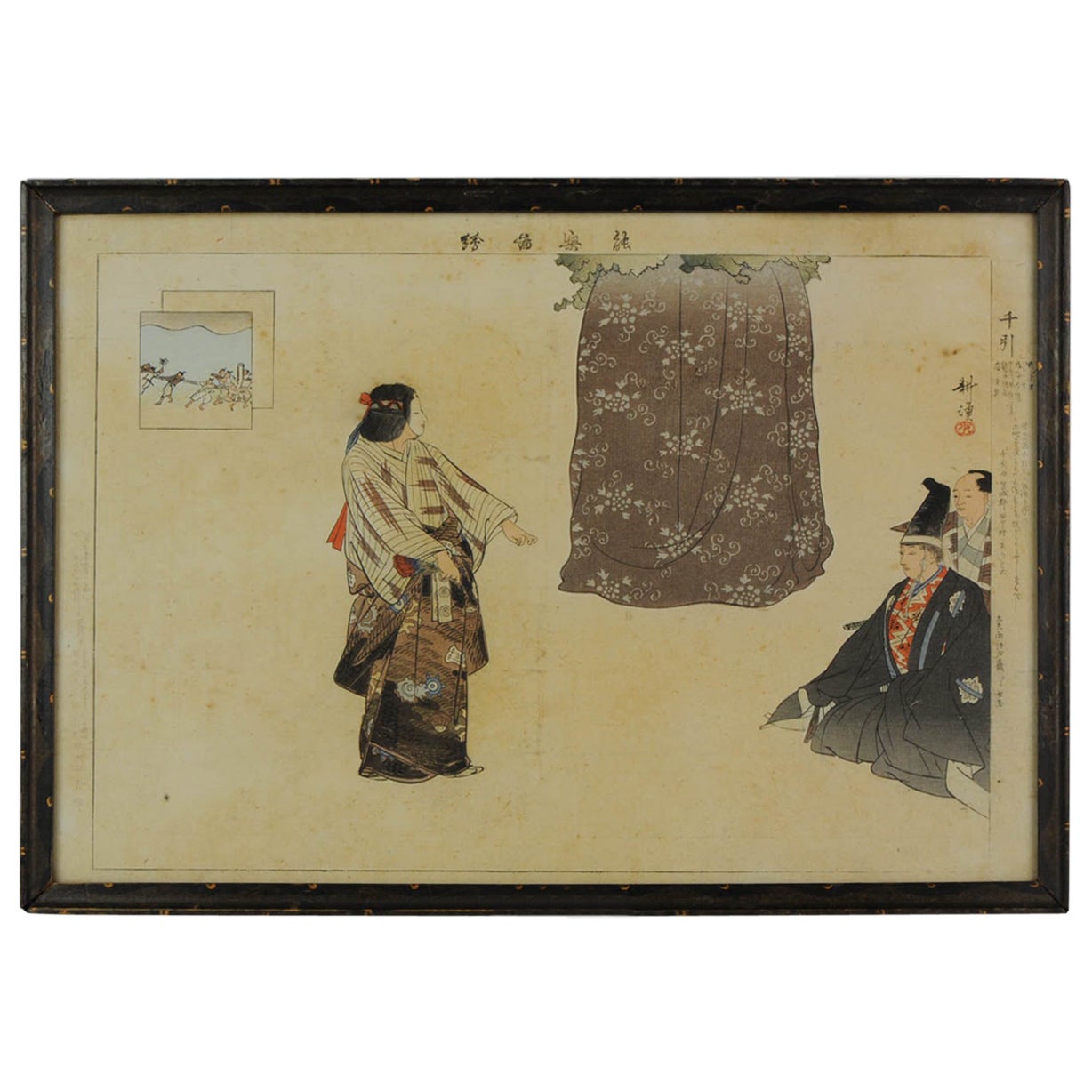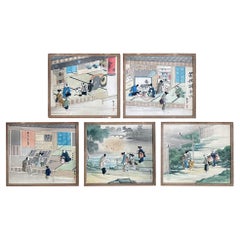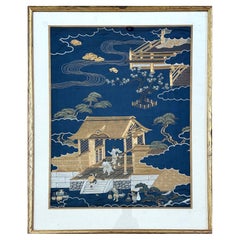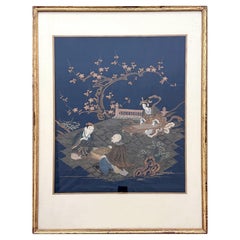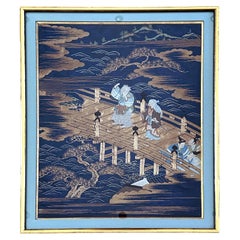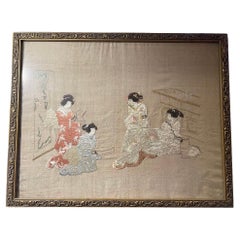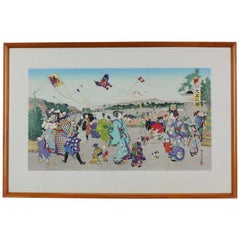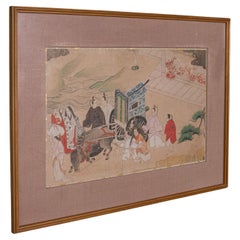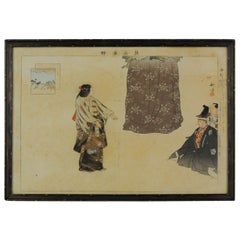Items Similar to Framed Japanese Oshi-E Textile Art Meiji Period
Want more images or videos?
Request additional images or videos from the seller
1 of 9
Framed Japanese Oshi-E Textile Art Meiji Period
$3,000
£2,307.80
€2,678.70
CA$4,230.72
A$4,739.11
CHF 2,489.15
MX$57,626.10
NOK 31,520.82
SEK 29,921.73
DKK 19,992.17
About the Item
On offer is the last one of the set of seven framed Japanese textile art called Oshi-E circa Meiji Period (1868-1912). This rare set consists of seven panels depicting various aspects of daily life in Edo time with stunning details. These snapshots of moments not only reveal the buzzling commercial activities at the marketplace, but also provide insight into the signages, architecture, costumes and how people interacted within a historical and pictorial context. They are beautifully framed in matching red giltwood frame of faux bamboo form with linen mat and gilt and cork trim. We rarely come across fine Oshi-E textile work, not mentioning a large group such as this. We offer them for sale individually but it will be great for a collector to consider the whole set so that they can stay together.
The set include seven lively scenes that mostly center on specialized merchants and shops with customers: a fabric store, a book-binding studio, a stone carving workshop, a basket-making studio and shop, a bottega that makes and sells brush pens and ink stones, a pastry and tofu house, and finally a lantern-viewing party at a tea house. The realistic rendering and attention to details are not short of "photographic" quality. From the signage of the shops, to the motions and attires of the individual characters, from the hairstyle, small ornaments, down to the facial expression, were all recorded in great details. Each panel was signed with the artist's name Yukihana in Kanji with a red seal.
The Oshi-E (also known as kiritori zaiku) is a type of ornamental textile art dated back to the Muromachi period (1392-1573). It started among the elite aristocratic women in Kyoto before spreading wider in the Japanese society. Throughout Edo and Meiji period, Oshi-E were sometimes used to make offerings to the altars in the temple and in the late 19th century, it was exported to the west along with the other embroidery textile art. Oshi-E was made by using silk wadding to create a relief design. Various silk fabric swaps and sometimes wires and tassels, often recycled from older kimonos among the other pieces, were used to create different desired effects. Much details were focused on the elaborate dresses, head wears, faces, and plants in the setting. Ink and watercolors were used to facilitate the details of the design such as the background painting and the facial detailing. The work was time-consuming and in Meiji period, it was considered as a feminine accomplishment along with ikebana, embroidery and tea ceremony. According to the book: Threads of silk and gold: ornamental textile from Meiji Japan published by Ashmolean museum of art and archaeology University of Oxford, few examples survived to this day.
Reference: Threads of Silk and Gold: Ornamental Textile from Meiji Japan published by Ashmolean museum of art and archaeology University of Oxford. Page 178.
- Dimensions:Height: 18 in (45.72 cm)Width: 19.5 in (49.53 cm)Depth: 0.5 in (1.27 cm)
- Style:Japonisme (Of the Period)
- Materials and Techniques:
- Place of Origin:
- Period:
- Date of Manufacture:1880s-1910s
- Condition:Wear consistent with age and use. Fine condition, not examined out of the frame.
- Seller Location:Atlanta, GA
- Reference Number:1stDibs: LU945025237402
About the Seller
4.9
Platinum Seller
Premium sellers with a 4.7+ rating and 24-hour response times
Established in 2006
1stDibs seller since 2010
565 sales on 1stDibs
Typical response time: <1 hour
- ShippingRetrieving quote...Shipping from: Atlanta, GA
- Return Policy
Authenticity Guarantee
In the unlikely event there’s an issue with an item’s authenticity, contact us within 1 year for a full refund. DetailsMoney-Back Guarantee
If your item is not as described, is damaged in transit, or does not arrive, contact us within 7 days for a full refund. Details24-Hour Cancellation
You have a 24-hour grace period in which to reconsider your purchase, with no questions asked.Vetted Professional Sellers
Our world-class sellers must adhere to strict standards for service and quality, maintaining the integrity of our listings.Price-Match Guarantee
If you find that a seller listed the same item for a lower price elsewhere, we’ll match it.Trusted Global Delivery
Our best-in-class carrier network provides specialized shipping options worldwide, including custom delivery.More From This Seller
View AllCollection of Five Japanese Oshi-E Textile Art Panels Meiji Period
Located in Atlanta, GA
On offer is a set of five Japanese textile art panels called Oshi-E circa Meiji Period (1868-1912). This usual set of panels depict various aspects of daily life in Edo time with beautiful details. Some of these panels are snapshots of the buzzling commercial activities at the marketplace, providing insight into the signages, architecture, costumes and how people interacted within a historical and pictorial context. Other panels depict daily leisure activities such as lounging in the park or visiting friends. The realistic rendering and attention to details are not short of "photographic" quality. From the signage of the shops to the motions and attires of the individual characters, from the hairstyle, small ornaments, down to the facial expression, were all recorded in great details. Each panel was signed with the artist's name Yukihana in Kanji with a red seal.
These panels are unframed and await your custom touch (framing with inner gilt spacer and mat costs about 250-500 depending on the material chosen, see a framed example in the last picture of a single framed panel we have for sale). We offer them for sale individually, but it will be great for a collector to consider the whole set so that they can stay together.
The Oshi-E (also known as kiritori zaiku) is a type of ornamental textile art dated back to the Muromachi period (1392-1573). It started among the elite aristocratic women in Kyoto before spreading wider in the Japanese society. Throughout Edo and Meiji period, Oshi-E were sometimes used to make offerings to the altars in the temple and in the late 19th century, it was exported to the west along with the other embroidery textile art. Oshi-E was made by using silk wadding to create a relief design. Various silk fabric swaps and sometimes wires and tassels, often recycled from older kimonos...
Category
Antique 1890s Japanese Japonisme Textiles
Materials
Silk, Giltwood
Framed Antique Japanese Embroidery Fukusa Textile Panel
Located in Atlanta, GA
A Japanese silk Fukusa Panel housed in a gilt frame circa late 19th century of Meiji Period. Fukusa is a traditional Japanese textile art used as a wrap for presenting gifts at important occasions. On the deep blue background, the elaborate embroidery work depicts a historical scene where street vendors selling goods to a royal household or an aristocratic residence. The scene focuses on the activities at the front gate where the couriers and servants were busying carrying the goods in. A peasant with straw coat...
Category
Antique Late 19th Century Japanese Meiji Textiles
Materials
Silk, Wood
Framed Antique Japanese Embroidery Fukusa Textile Panel
Located in Atlanta, GA
A Japanese silk Fukusa Panel housed in a gilt frame circa late 19th century of Meiji Period. Fukusa is a traditional Japanese textile art used as a wrap for presenting gifts at important occasions. On the deep blue background, the elaborate embroidery work depicts three deities of the Shichifukujin (Seven Gods of Fortune...
Category
Antique Late 19th Century Japanese Meiji Textiles
Materials
Silk, Wood
Framed Antique Japanese Embroidery Fukusa Panel Takasago Legend
Located in Atlanta, GA
A finely embroidered Japanese silk Fukusa panel presented in a beautiful silk-lined giltwood frame (newly framed and glazed), circa late 19th century of Meiji Period. Fukusa is a traditional Japanese textile art used to wrap and present gifts at important occasions. Depending on the occasion, the panel itself can be a very fine textile art on its own.
On the deep blue background, this elaborate textile art depicts an old couple standing on a bridge with three bystanders, flanked by pine trees with hills afar. The couple is Jotomba (Joo and Uba are their respective names), characters in the Legend of Takasago, one of the oldest Japanese mythologies, who are associated with old pines. The legend goes as: "At Takasago Shrine there is a very old pine tree, the trunk of which is bifurcated; in it dwells the spirit of the Maiden of Takasago who was seen once by the son of Izanagi who fell in love and wedded her. Both lived to a very great age, dying at the same hour on the same day, and since then their spirits abide in the tree, but on moonlight nights they return to human shape to revisit the scene of their earthly felicity and pursue their work of gathering pine needles. His pine tree is called “The Pine of Suminoe” while hers is "Takasago pine".
In Japan, Takasago couple...
Category
Antique Late 19th Century Japanese Meiji Textiles
Materials
Silk, Wood
Framed Japanese Woven Textile Panel with Dragon Meiji Period
Located in Atlanta, GA
A framed Japanese woven textile circa late 19th century of Meiji Period. Likely a fragment of a priest robe or kesa, the multi-paneled textile was finely woven with gold foiled threads that depicts a five-clawed dragon slithering in the clouds and water...
Category
Antique 19th Century Japanese Meiji Textiles
Materials
Silk, Wood
Framed Antique Japanese Embroidery Fukusa Panel
Located in Atlanta, GA
A finely embroidered Japanese silk Fukusa panel presented in a beautiful silk-lined giltwood frame (newly framed and glazed), circa late 19th century of Meiji Period. Fukusa is a tra...
Category
Antique Late 19th Century Japanese Meiji Textiles
Materials
Silk, Wood
You May Also Like
Mid-20th Century Japanese silk embroidered framed painting
Located in Delft, NL
Mid-20th Century Japanese silk embroidered framed painting
A silk embroidered painting and is framed behind glass with a scene of women in ...
Category
Mid-20th Century Japanese Paintings and Screens
Materials
Silk
Antique Japanese 19th Century Blockprint in Frame Japan Edo or Meiji
Located in Amsterdam, Noord Holland
A very nice blockprint
10-9-18-rof-300
Condition:
Overall condition perfect. Size frame: 535 x 362 mm
Period:
19th century Edo period (1603-1867)
Meiji Periode(1867-1912).
Category
Antique 19th Century Japanese Meiji Ceramics
Materials
Paper
$838 Sale Price
20% Off
Antique Framed Woodblock Print, Japanese, After Heian, Art, Victorian, C.1900
Located in Hele, Devon, GB
This is an antique framed woodblock print. A Japanese, after Heian era art scene, dating to the late Victorian period, circa 1900.
The Heian period of ...
Category
Antique Late 19th Century Japanese Decorative Art
Materials
Pine
Lovely Japanese Blockprint Made by Kogyo Antique Meiji, 19th century
Located in Amsterdam, Noord Holland
Interesting and finely painted Japanese painting. Marked Kogyo.
Additional information:
Material: Paper
Type: Paintings, Scrolls & Prints
Region of Origin: Japan
Period: ca 1900
Age...
Category
Antique 19th Century Japanese Prints
Materials
Paper
$398 Sale Price
20% Off
19th Century Japanese Framed Hand-Painted on Silk
Located in Marbella, ES
19th century Japanese framed hand painted on Silk.
Category
Antique 19th Century Japanese Paintings
Materials
Silk, Wood
Japanese Asian Edo Period Tosa School Original Painting Imperial Court Officials
Located in Studio City, CA
A beautiful and very engaging Edo Period (1603-1868) Japanese Tosa school original painting featuring two officials from the Imperial Court.
The Tosa school (土佐派,) of Japanese pai...
Category
Antique 1830s Japanese Edo Paintings and Screens
Materials
Wood, Paint, Paper
More Ways To Browse
Textile Art
Framed Textile
Framing Antique Textiles
Japanese Fabric Art
Antique Fabrics And Textiles Fabric Textiles
Book Binding
Framed Textile Panel
Asian Framed Silk Art
Antique Japanese Book
Furniture Silk Tassels
Framed Japanese Textiles
Meiji Silk
Antique Book Bindings
Antique Japanese Textiles
Edo Frames
Asian Fabric Panels
Antique Gold Silk Fabric
Antique Ink Stone
